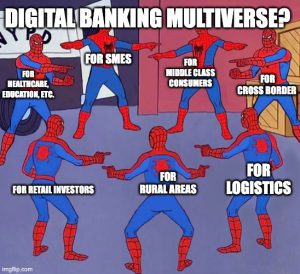This article brings together insights shared from interviews of Insignia Ventures founding managing partner Yinglan Tan with Tech in Asia, parts of which have been quoted in the “As digibanks rise, will Indonesia’s online lenders become obsolete?” piece by Budi Sutrisno and “Behind Ajaib’s $100m push to become a digital bank” by Aditya Hadi Pratama
Highlights
- Building out the banking stack is becoming a predominant path to scale for many fintechs but there many ways to go about it depending on the availability of licenses, competitive landscape, and the fintech’s core service / product-market fit.
- Digital banking can be an evolution of lending propositions, fuelled by deposits rather than external funding
- Digital banking stacks are put together through a combination of “build”, “invest” or “buy”, and “partner”.
- The digital banking trajectory poses opportunity to close the gaps (quite literally) between digital-first and traditional players through investments and M&A.
- For Indonesia in particular, digital banking, as with many sectors in this massive market, is not necessarily a winner-takes-all competitive landscape, but more likely an environment where “winners-takes-what-they-are-good-at.”
As Southeast Asia’s fintechs continue to mature and evolve, we’re seeing many of them take the digital banking trajectory, whether for consumers, businesses, or both. In 2020 we’ve already written about this rebundling of banking stack through digital propositions, and in 2022 we’re seeing these rebundling efforts materialize.
Then there are also some fintechs that are just skipping the whole evolution altogether and kicking things off with a fully digital banking proposition, knowing that the demand is already there and adoption for various parts of the banking stack has been proven to some degree in Southeast Asia.
As the digital banking landscape in Southeast Asia heats up, we compare a few of the digital banking trajectories that we’ve had the pleasure of supporting and seeing evolve up close and their implications for the financial services market, especially in Indonesia:
- Digital banking as an avenue for more sustainable financial inclusion (and Digital Banking is not the only growth trajectory)
- Digital banking as a combination of core service expansion and adjacency partnerships
- Digital banking closing the gap between digital-first and traditional players
While building out the banking stack is becoming the predominant path to scale for many fintechs but there many ways to go about it depending on the availability and definition (i.e. license per service or full digital banking license) of licenses, competitive landscape (i.e. not just about who else is becoming a digital bank but also who are potential partners or investments), and the nature of the fintech’s core service.
Bringing sustainability to lending propositions
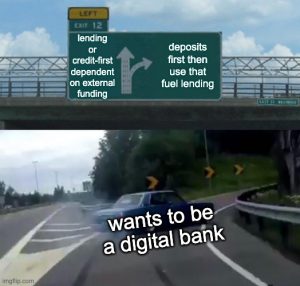
Emerging markets in Southeast Asia (apart from Singapore) have long been characterized by having largely unbanked and underbanked populations with little to no access to credit or affordable financing.
This has made lending a popular service in the region for fintechs, and we’ve seen this evolve from pure P2P lending and microfinance to BNPL as the sources of data to build up underwriting capabilities and credit scoring has expanded over time. But the main challenge for P2P lenders or digital lending-only platforms in general is scalable liabilities.
As shared on Tech in Asia: “[Online lenders] are dependent on external funding to fuel their lending propositions…As P2P lenders start out, it may not be as much of an issue. But in order to continue sustainably expanding their offerings, greater weight is placed on ensuring that the funding does come in to fuel the loans.”
On the other hand, for fully digital banking propositions, they have the ability to leverage deposits as fuel. In the Philippines, Tonik is doing this to great effect having gathered a record amount of this “fuel” (US$50 million in 3 months after launch and more than US$130 million in February 2022) which they then have been able to use for their consumer loan offerings.
As Tonik CEO and founder Greg Krasnov illustrates the significance of this fuel the lending proposition on our podcast, “The digital lending guys, it’s so great that they’re doing it, and there are some guys that are bringing some really good know-how, but they don’t have scalable liabilities. They’re borrowing from banks, for example credit lines of US$1 million or US$2 million here and there. And that’s just not gonna feed the fire…if you don’t have access to a big amount of funding, you’re going to be marginalized. That for us is a very exciting opportunity.” It’s worth noting that prior to Tonik, Greg was trying to drive adoption for lending in the Philippines but found it challenging partly for this reason.
Economics 101 also tells us that with enough supply, prices can be adjusted down, and in the same way, with a more sustainable and scalable flow on the deposit side, digital banks could in theory offer more competitive interest rates than funding-dependent lenders.
As shared on Tech in Asia: “With a more sustainable and scalable flow on the deposit side, digibanks could theoretically offer more competitive interest rates than funding-dependent lenders.”
Go banking or go broke? That’s not really the question
While it seems that full digital banking propositions may have the long-term upper hand in offering lending, online lending is not entirely locked out of building out their own banking stack as many fintechs are doing.
While online lenders are able to tap into their existing mine of data for credit assessment and customer distribution quickly, it can be a challenging juggling act to set up both sides of the digital banking balance sheet and additional services if the core lending proposition itself is not in a stable situation (i.e. accounts receivables hanging in the air and collection is not efficient enough).
When it comes to creating progressive product-market fits, it’s key to evaluate the risk of dropping the ball on existing PMFs before venturing into new ones.
There’s merit in focusing purely on the lending offering but especially if the company aims to scale geographically or across market segments, there’s that concentration risk in terms of monetization, compounded even further if that monetization needs to be fuelled by external funding.
That said, there will still be lending platforms that will exist to cater to more specific needs or are tied to specific market segments, but the ones that dominate will likely be digital banks able to more sustainably leverage having both the asset and liability side covered within their business model. For many lending platforms, lending itself is just the beginning of their product flywheel.
At the end of the day, the emergence of the digital lending platforms initially was a response of the traditional finance system to cater to a massive underserved segment of borrowers. This has been the case with most fintechs; they are driven by the market gaps of the incumbents.
Because digital banks also evolved from this fintech revolution, their differentiation from P2P platforms may not always be a clear cut compared to how banks and multifinance were delineated, especially with regards to how they may try to increase or support the quality of their borrowers.
As shared on Tech in Asia: “We can also expect to see more acquisitions or even minority investments of P2P lenders from the more developed banking stacks.”
Digital Banking not the only trajectory for fintechs
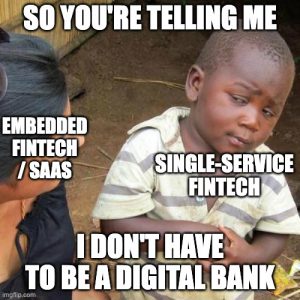
With this momentum towards full-stack ecosystems and consolidation, online lenders will need to have a clear sense of what scale will look like for their respective platforms, and digital banking may not be the sole direction. Some platforms that started out with financing, albeit for SMEs and not consumers, have also ventured into SaaS offerings and embedded finance, as in the case of AwanTunai.
As AwanTunai CEO Dino Setiawan shares on our podcast on how their performance with their lending proposition unlocked stability through their SaaS offering as well, “We went through the worst credit cycle in recent history and achieved a 97% recovery rate. So that’s 3% NPL in a very difficult environment. And to a certain extent, it is a testament to how fast we were able to adapt to the desperate situation, deploy our SaaS systems to control risk…And that’s why we really lead in with the low-cost working capital. Everybody needs that in this particular segment. And it’s the lending that actually pulls the SaaS adoption at this supplier level. And that’s how we build our supply network.”
Learn more about AwanTunai’s lending to SaaS + embedded financing trajectory in this case study
Gotta catch them all
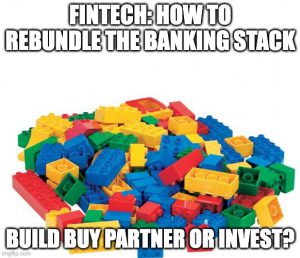
Apart from day one full digital banking propositions, other fintechs are building up their banking stack through a mix of different product / service acquisition strategies, like putting together Lego pieces from different sets to build something totally new and outside of the instruction manual.
For example, Fazz Financial has been acquiring key licenses to launch in-house services ranging from payments to loans and money transfer as well as investing in startups with adjacent services like Xfers with their banking infrastructure (which ultimately led to the formation of Fazz Financial from Payfazz), Modal Rakyat with their P2P lending platform, and CrediBook with their digital bookkeeping app.
This flexibility has allowed fintechs to focus on developing core services while still being able to retain and grow their customer base through an ecosystem of offerings that are not limited to these core services.
This approach is not cheap, however, and it comes with having that foundations of an existing core product-market fit and moat driving stable cash flow. In the case of Payfazz, it was their digital-first agent-led banking network across rural Indonesia that had already bagged them significant revenues and funding before they evolved into Fazz Financial with Xfers.
Closing the generational gap
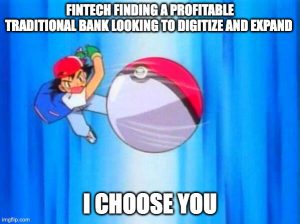
Then there are fintechs that go on the digital banking route through the opportunities presented by a landscape filled with traditional banks and financial service incumbents looking to go digital or tap into new services more easily.
Ajaib found its product-market fit and became a billion dollar company through its platform primarily built for first-time millennial investors to grow their savings through mutual fund investing and stock investing, but this is just the tip of the iceberg for what Ajaib can be in this space of personal wealth management and personal finance in Indonesia.
As CEO and co-founder Anderson Sumarli shared on our podcast with him back in 2020 just as they had launched their stock trading app, “We really want to be that resource — that one-stop-shop for anybody who wants to invest in any asset class to come to us…and we’ll set them up with our tools and resources for success.”
We also put together a short case study on Ajaib’s growth trajectory thus far leading up their unicorn round.
Investing and later doubling down on Bank Bumi Arta is consistent with that desire to be the all-in-one platform for retail investors to easily access tools and resources to invest across a range of asset classes.
The digital banking trajectory, for many fintechs, offers a concrete path to strengthening retention in their user base while also opening up multiple touchpoints for new users to enter their ecosystem of offerings.
As shared on Tech in Asia: “This trajectory enables Ajaib to have stronger ownership over distribution and greater visibility into the full customer journey. This will not only create flexibility for users but also increase their long-term trust and usage, which is critical in developing monetization and profitability.”
This is not the first time Ajaib has invested in a traditional player; their foray into stock trading kicked off with the acquisition of 40 year-old traditional stock brokerage Primasia Sekuritas.
Rise of (Digital Banking) Kingdoms in Indonesia
What’s been interesting to see emerge in the sector across Southeast Asia are digital banking players coming from different angles or core propositions, carrying with them unique moats, and building out their digital banking proposition through various methods. Again this is because of the differences in regulation, competitive landscapes, and fintech core services across markets.
Ajaib for example is building out its banking stack coming from their strength in the retail investment segment and through key investments and acquisitions to acquire key licenses (e.g. they made their foray into stock brokerages through an acquisition). On the other hand, there’s Fazz Financial, which has been building their banking stack coming from their strength in rural Indonesia and SME finance. Then at the beginning of the article we talked about Tonik’s approach already solving the single-serve lending proposition challenges from day one with a deposit-fuelled full digital banking proposition in the Philippines.
For Indonesia’s digital banking space in particular, as with many sectors in this massive market, is not a winner-takes-all competitive landscape, but more likely an environment where “winners-takes-what-they-are-good-at.”
As shared on Tech in Asia: “Indonesia’s digital banking space is not a “winner-takes-all” competition, but more likely an environment where “winners take what they are good at…“It is highly possible that as the market evolves, you’ll have these “kingdoms” of market leaders where individual Indonesians have accounts in more than one of these players.””
We also write about this competitive landscape reality in this article on the rise of counter-position companies in Indonesia: “It’s clear that we are just at the tip of the iceberg when it comes to the full potential of Indonesia’s digital economy. Perhaps it’s not a competitive landscape where the winner-takes-all, but the winner-takes-some or “the winner takes what they are good at and then some”.
Paulo Joquiño is a writer and content producer for tech companies, and co-author of the book Navigating ASEANnovation. He is currently Editor of Insignia Business Review, the official publication of Insignia Ventures Partners, and senior content strategist for the venture capital firm, where he started right after graduation. As a university student, he took up multiple work opportunities in content and marketing for startups in Asia. These included interning as an associate at G3 Partners, a Seoul-based marketing agency for tech startups, running tech community engagements at coworking space and business community, ASPACE Philippines, and interning at workspace marketplace FlySpaces. He graduated with a BS Management Engineering at Ateneo de Manila University in 2019.
